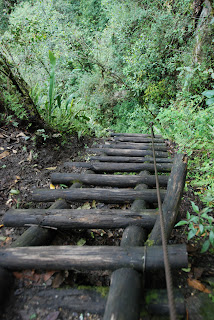There were what seemed to be hundreds of people in line for the buses and I thought, "Oh, great, we will have to deal with crowds all day long....", but amazingly, once we arrived, everyone seemed to disperse and crowds were not an issue. The bus ride was a twisty, turny ride on hairpin curves on a dirt road. I am amazed at the skill of the bus drivers. Everyone seemed full of anticipation and I know that although I tried to relax, I was not wanting to miss anything. I plan to post many pictures of Machu Picchu, since it was the most important part of my trip, so I hope not to bore you.

Well---here we are...Machu Picchu!!! ---the climax of the trip! It was everything I had imagined, and more! It was beautiful, mystical, other-worldly... amazing! I think we were very lucky to have gone during the off season, when it wasn't overrun by tourists.
This picture shows Machu Picchu at around 7:30 a.m. when we first arrived. You can see in the middle a room that is being renovated, the Temple of the Sun. I did some photoshopping on this picture in another view and erased the tarps, etc., but, in this picture you see it exactly as we saw it. The wispy clouds hanging over the Andes mountains added to the ethereal quality of the site. What amazed me most was how quiet everyone was. It was as though everyone could feel the spirituality.

This is the sacred Inca mountain, Putukusi, which Grant and I hiked yesterday. The part we hiked was on the back side, away from what you can see here, but if you look at the very top, that's where we ended up and got the cloud shrouded view of Machu Picchu.

The llamas are the only official residents of Machu Picchu. They seem very happy in their home and not at all intimidated by the visitors.
In this picture you can see the part of Machu Picchu called the Industrial Sector with Mount Putukusi in the background.























